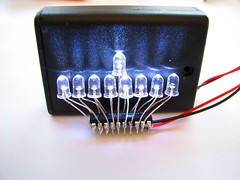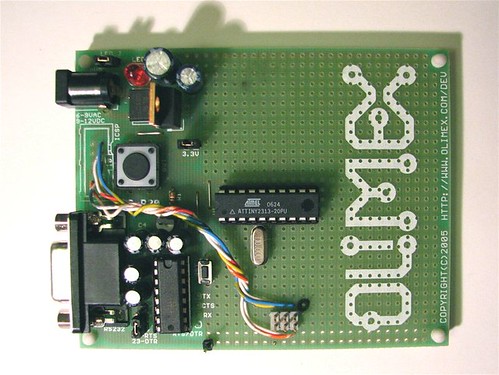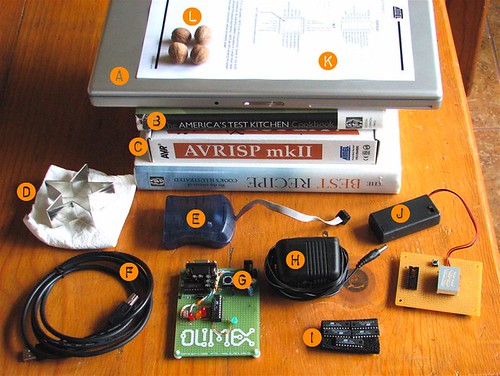This article contains some reference data relevant to the holiday electronics projects.
Continue reading Holiday Electronics Projects: Technical details and Reference data
All posts by Windell Oskay
LED Holiday Project Kits
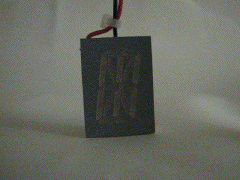
We have written instructions for building two sweet microcontroller-based electronics projects for the holidays: an alphanumeric LED christmas tree ornament and an LED mini-menorah (hanukkiah).
These are open-source projects; You can download and modify the source code, use it to program your own microcontroller, and solder the microcontroller to some LEDs to help make your own holiday decorations.
If programming microcontrollers is not your idea of a good time, we understand. Not everyone has (1) access to a microcontroller programmer, (2) the time and (3) the desire to modify the firmware of their christmas tree ornaments.
Low-cost open-source holiday project kits brought to you by Evil Mad Scientist Laboratories.
In order to help our fellow citizens Evil Mad Scientists with their holiday projects, we have put together electronic soldering kits for these projects. (Updated: November 2007)
LED mini-menorah kits are now available at our new web store.

Kits for version 2.0 of the open-source LED Micro-Readerboard project are now available at the Make Store.
Holiday electronics projects: Support discussions
This *was* the place to discuss tricks, tips, and troubles with the holiday electronics projects.
However, we’ve moved future support (and the discussions that were here) to the
Discussion Forums.
Programming the Atmel ATtiny2313 in Mac OS X
For a recent project, I needed to control sixteen or seventeen LEDs with a microprocessor. The one that I chose was the Atmel ATtiny2313, because it has 20 pins, with up to eighteen outputs, can run without an external oscillator, and is fairly inexpensive at around $2.00 per piece.
Since I’ve got a Mac laptop and no real serial or parallel port, I opted to go with a USB-based programming solution. Furthermore, I wanted to program in C, not assembler, and use open source development tools. Since I was (eventually) successful in all of these goals, I thought that I should write up a few notes about it.
Continue reading Programming the Atmel ATtiny2313 in Mac OS X
Sneak peek
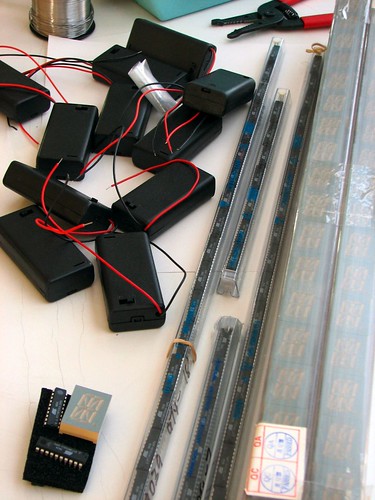
Chips, tubes, boxes, solder…. What are those Evil Mad Scientists up to now?
update: cat… bag…
Turn an RC car into a floor sweeper!
What’s fun, cheap, good looking, and cleans a hardwood floor with an advanced search and navigation algorithm?
An electrostatic dust mop attached to a radio-controlled car. Vroom!
This combination has some things in common with a Roomba, but is arguably less expensive. It’s quick and fun to build, and quick and fun to operate.
Continue reading Turn an RC car into a floor sweeper!
Play with your food: A Chocolate Debian
Every year we make chocolate truffles for the holidays. This year, we made Thanksgiving-themed truffles with dried cranberries and freshly candied orange peel, labeled with a little curl of red-colored white chocolate. We’ve decided to name this particular treat a “Chocolate Debian,” for reasons that may be obvious to some.
What I took with me for Thanksgiving
The lab staff is travelling this week. Here’s what I brought with me, which might give you a hint about some of our upcoming projects:
- A: MacBook Pro
- B: Cookbooks (We’re doing the cooking!)
- C: AVRISP mkII microcontroller programmer box
- D: Star-shaped
cookiebiscuit cutter
- E: The microcontroller programmer itself (fits in the box)
- F: USB cable for programmer (fits in the box)
- G: Olimex development board for 20-pin AVR chips (fits in the box)
- H: Power for the Olimex board
- I: Ten Atmel ATtiny2313 microcontrollers (fit in the box)
- J: Microcontroller target board with 17-segment LED display and battery box (fits in the box)
- K: Sheet from ATtiny2313 data sheet showing pinouts
- L: Four fresh nutmeg nuts. (Meg nuts?)
Art lamp and JellyBean: Separated at birth?
We made– and sold (!)– this art lamp a couple of years ago. It’s a life-sized hollow glass head glued to an aluminum base. Inside the head are two long, tangled, strands of multicolored christmas lights, each with a bimetallic “blinky” bulb. The two halves switch on and off quite irregularly in an animated effect that seems much more complex than the simple electronics should have produced. The end effect is a bit like neurons firing, or perhaps like the brain from a cheesy tv robot.
In this photo, JellyBean is sitting on the top of the bookcase with the lamp and is doing her best to blend in with the surroundings– cats are good at that.
See more pictures of the Evil Mad Scientist Laboratories Feline Auxiliary here.
Vintage Remote TV-B-Gone Case Mod
Turn off that television in classic style!
Here we show you how to hack a TV-B-Gone into the case of a vintage television remote control, such that the original on/off button instead activates the TV-B-Gone. We also modify the power supply so that it runs off of a regular 9 V battery, instead of a set of lithium coin cells.
Continue reading Vintage Remote TV-B-Gone Case Mod




